
Artillery is a class of heavy military ranged weapons that launch munitions far beyond the range and power of infantry firearms. Early artillery development focused on the ability to breach defensive walls and fortifications during sieges, and led to heavy, fairly immobile siege engines. As technology improved, lighter, more mobile field artillery cannons developed for battlefield use. This development continues today; modern self-propelled artillery vehicles are highly mobile weapons of great versatility generally providing the largest share of an army's total firepower.

USS Massachusetts was an Indiana-class, pre-dreadnought battleship and the second United States Navy ship comparable to foreign battleships of its time. Authorized in 1890, and commissioned six years later, she was a small battleship, though with heavy armor and ordnance. The ship class also pioneered the use of an intermediate battery. She was designed for coastal defense and as a result, her decks were not safe from high waves on the open ocean.
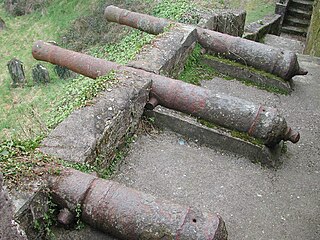
In military organizations, an artillery battery is a unit or multiple systems of artillery, mortar systems, rocket artillery, multiple rocket launchers, surface-to-surface missiles, ballistic missiles, cruise missiles, etc., so grouped to facilitate better battlefield communication and command and control, as well as to provide dispersion for its constituent gunnery crews and their systems. The term is also used in a naval context to describe groups of guns on warships.

Castillo San Felipe del Morro, also known as El Morro, is a citadel built between 16th and 18th centuries in San Juan, Puerto Rico.

The Battle of El Caney was fought on July 1, 1898, during the Spanish-American War. 600 Spanish soldiers held for twelve hours, until they ran out of ammunition, against Henry W. Lawton's 5th US Division, made up of 6,899 men. This action temporarily delayed the American advance on the San Juan Hills, as had been requested of General William Rufus Shafter. Nevertheless, American forces advanced on San Juan Hill the same day. Though encountering spirited resistance similar to El Caney, the Americans were ultimately victorious, culminating in the capitulation of the Spanish garrison.

The Puerto Rico campaign was the American military sea and land operation on the island of Puerto Rico during the Spanish–American War. The offensive began on May 12, 1898, when the United States Navy attacked the capital, San Juan. Though the damage inflicted on the city was minimal, the Americans were able to establish a blockade in the city's harbor, San Juan Bay. On June 22, the cruiser Isabel II and the destroyer Terror delivered a Spanish counterattack, but were unable to break the blockade and Terror was damaged.
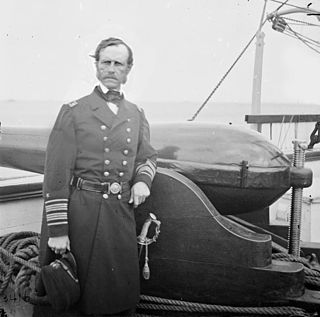
Dahlgren guns were muzzle-loading naval artillery designed by Rear Admiral John A. Dahlgren USN, mostly used in the period of the American Civil War. Dahlgren's design philosophy evolved from an accidental explosion in 1849 of a 32 lb (14.5 kg) gun being tested for accuracy, killing a gunner. He believed a safer, more powerful naval cannon could be designed using more scientific design criteria. Dahlgren guns were designed with a smooth curved shape, equalizing strain and concentrating more weight of metal in the gun breech where the greatest pressure of expanding propellant gases needed to be met to keep the gun from bursting. Because of their rounded contours, Dahlgren guns were nicknamed "soda bottles", a shape which became their most identifiable characteristic.

The Hotchkiss gun can refer to different products of the Hotchkiss arms company starting in the late 19th century. It usually refers to the 1.65-inch (42 mm) light mountain gun; there were also a navy (47 mm) and a 3-inch (76 mm) Hotchkiss guns. The 42 mm gun was intended to be mounted on a light carriage or packed on two mules to accompany a troop of cavalry or an army travelling in rough country.

Field artillery in the American Civil War refers to the artillery weapons, equipment, and practices used by the Artillery branch to support the infantry and cavalry forces in the field. It does not include siege artillery, use of artillery in fixed fortifications, or coastal or naval artillery. Nor does it include smaller, specialized artillery classified as small arms.

Several boards have been appointed by US presidents or Congress to evaluate the US defensive fortifications, primarily coastal defenses near strategically important harbors on the US shores, its territories, and its protectorates.
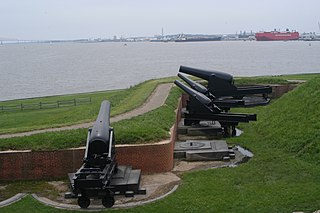
Seacoast defense was a major concern for the United States from its independence until World War II. Before airplanes, many of America's enemies could only reach it from the sea, making coastal forts an economical alternative to standing armies or a large navy. After the 1940s, it was recognized that fixed fortifications were obsolete and ineffective against aircraft and missiles. However, in prior eras foreign fleets were a realistic threat, and substantial fortifications were built at key locations, especially protecting major harbors.

The Bombardment of San Juan, or the First Battle of San Juan, on 12 May 1898 was an engagement between United States Navy warships and the Spanish fortifications of San Juan, Puerto Rico. It was the first major action of the Puerto Rican Campaign during the Spanish–American War.

The Santa Clara Battery, with its two remaining coastal guns, one a caliber 305mm (12") Ordóñez HSE Modelo 1892 rifle and the other a 280mm (11") Krupp, stands on the grounds of the Hotel Nacional de Cuba, in Vedado, Havana. UNESCO in 1982 included the battery, together with Old Havana, in its list of UNESCO World Heritage sites. There is a small museum featuring the 1962 Cuban Missile Crisis in the battery. During the crisis, Fidel Castro and Che Guevara set up their headquarters there to prepare the defense of Havana from aerial attack. The museum is in tunnels there known as the Cueva Taganana, for the hill on which the battery stands.

Ordóñez guns are a type of late 19th century coastal artillery. Ranging in caliber from 150 mm (5.9 in) to 305 mm (12.0 in), most of the models were field guns, but some were howitzers. Salvador Diaz Ordóñez, an artillery officer in the Spanish Army, designed the guns, and they were made in Asturias, Spain at the Trubia Arms Factory. The Spanish installed them in forts and batteries at home, for instance at Ceuta, and throughout their empire, in Puerto Rico, Cuba, and the Philippines. The Ordóñez guns appear to have been used for protecting Spain's colonies; reportedly the Spanish generally reserved the higher quality, and much more expensive, Hontoria guns for the defense of Spain.

Salvador Díaz Ordóñez y Escandón (1845–1911) was an artillery officer in the Spanish Army and the designer of several pieces of artillery, the Ordóñez guns. As a colonel, Ordóñez served in Cuba during the Spanish–American War, where he was wounded at Santiago de Cuba. He went on to reach the rank of General. He died on 14 October 1911 at Izhaven, near Melilla, from shots from a Rifian while inspecting the Spanish position there during the Kert campaign.
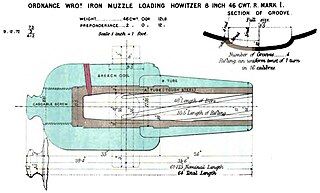
The RML 8-inch howitzer was a British Rifled, Muzzle Loading (RML) Howitzer manufactured in England in the 19th century, which fired a projectile weighing approximately 180 pounds (82 kg). It was used in siege batteries and in fortifications.

Barrio de San Lázaro is one of the first neighbourhoods in Havana, Cuba. It initially occupied the area bounded by Calle Infanta to the west, Calle Zanja to the south, Calle Belascoáin to the east, and the Gulf of Mexico to the north, forming the western edge of Centro Habana. According to the 1855 Ordenanzas Municipales of the city of Havana, Barrio San Lázaro was the Tercer Distrito and was Barrio No. 8.
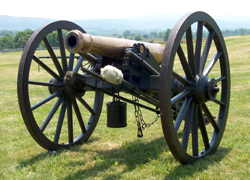
The M1841 6-pounder field gun was a bronze smoothbore muzzleloading cannon that was adopted by the United States Army in 1841 and used from the Mexican–American War to the American Civil War. It fired a 6.1 lb (2.8 kg) round shot up to a distance of 1,523 yd (1,393 m) at 5° elevation. It could also fire canister shot and spherical case shot (shrapnel). The cannon proved very effective when employed by light artillery units during the Mexican–American War. The cannon was used during the early years of the American Civil War, but it was soon outclassed by newer field guns such as the M1857 12-pounder Napoleon. In the U.S. Army, the 6-pounders were replaced as soon as more modern weapons became available and none were manufactured after 1862. However, the Confederate States Army continued to use the cannon for a longer period because the lesser industrial capacity of the South could not produce new guns as fast as the North.

The M1841 12-pounder howitzer was a bronze smoothbore muzzle-loading artillery piece that was adopted by the United States Army in 1841 and employed during the Mexican–American War and the American Civil War. It fired a 8.9 lb (4.0 kg) shell up to a distance of 1,072 yd (980 m) at 5° elevation. It could also fire canister shot and spherical case shot. The howitzer proved effective when employed by light artillery units during the Mexican–American War. The howitzer was used throughout the American Civil War, but it was outclassed by the 12-pounder Napoleon which combined the functions of both field gun and howitzer. In the U.S. Army, the 12-pounder howitzers were replaced as soon as more modern weapons became available. Though none were manufactured after 1862, the weapon was not officially discarded by the U.S. Army until 1868. The Confederate States of America also manufactured and employed the howitzer during the American Civil War.
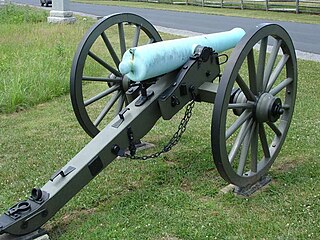
The M1857 12-pounder Napoleon or Light 12-pounder gun or 12-pounder gun-howitzer was a bronze smoothbore muzzleloading artillery piece that was adopted by the United States Army in 1857 and extensively employed in the American Civil War. The gun was the American-manufactured version of the French canon obusier de 12 which combined the functions of both field gun and howitzer. The weapon proved to be simple to produce, reliable, and robust. It fired a 12.03 lb (5.5 kg) round shot a distance of 1,619 to 1,680 yd at 5° elevation. It could also fire canister shot, common shell, and spherical case shot. The 12-pounder Napoleon outclassed and soon replaced the M1841 6-pounder field gun and the M1841 12-pounder howitzer in the U.S. Army, while replacement of these older weapons was slower in the Confederate States Army. A total of 1,157 were produced for the U.S. Army, all but a few in the period 1861–1863. The Confederate States of America utilized captured U.S. 12-pounder Napoleons and also manufactured about 500 during the war. The weapon was named after Napoleon III of France who helped develop the weapon.




















